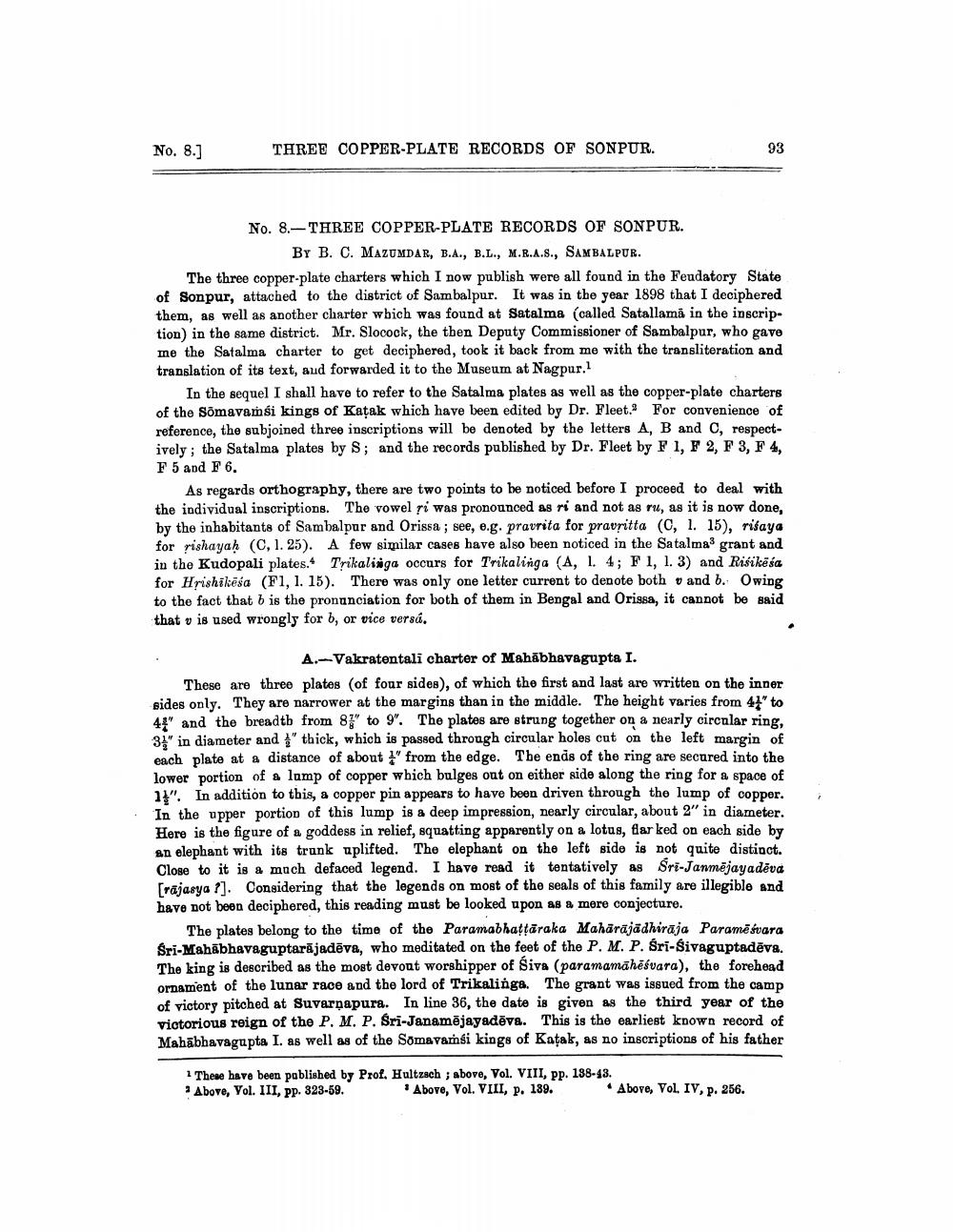________________
No. 8.]
THREE COPPER-PLATE RECORDS OF SONPUR.
No. 8.-THREE COPPER-PLATE RECORDS OF SONPUR. BY B. C. MAZUMDAR, B.A., B.L., M.R.A.S., SAMBALPUR.
The three copper-plate charters which I now publish were all found in the Feudatory State of Sonpur, attached to the district of Sambalpur. It was in the year 1898 that I deciphered them, as well as another charter which was found at Satalma (called Satallama in the inscription) in the same district. Mr. Slocock, the then Deputy Commissioner of Sambalpur, who gave me the Satalma charter to get deciphered, took it back from me with the transliteration and translation of its text, aud forwarded it to the Museum at Nagpur.1
93
In the sequel I shall have to refer to the Satalma plates as well as the copper-plate charters of the Sōmavamsi kings of Katak which have been edited by Dr. Fleet. For convenience of reference, the subjoined three inscriptions will be denoted by the letters A, B and C, respectively; the Satalma plates by S; and the records published by Dr. Fleet by F 1, F 2, F3, F4, F 5 and F 6.
As regards orthography, there are two points to be noticed before I proceed to deal with the individual inscriptions. The vowel ri was pronounced as ri and not as ru, as it is now done, by the inhabitants of Sambalpur and Orissa; see, e.g. pravrita for pravṛitta (C, 1. 15), risaya for rishayaḥ (C, 1. 25). A few similar cases have also been noticed in the Satalma3 grant and in the Kudopali plates. Trikalinga occurs for Trikalinga (A, I. 4; F 1, 1. 3) and Risikesa for Hrishikesa (F1, 1. 15). There was only one letter current to denote both and b. Owing to the fact that b is the pronunciation for both of them in Bengal and Orissa, it cannot be said that is used wrongly for b, or vice versa.
A.-Vakratentali charter of Mahabhavagupta I.
These are three plates (of four sides), of which the first and last are written on the inner sides only. They are narrower at the margins than in the middle. The height varies from 41" to 4" and the breadth from 8" to 9". The plates are strung together on a nearly circular ring, 3" in diameter and " thick, which is passed through circular holes cut on the left margin of each plate at a distance of about 1" from the edge. The ends of the ring are secured into the lower portion of a lump of copper which bulges out on either side along the ring for a space of 1". In addition to this, a copper pin appears to have been driven through the lump of copper. In the upper portion of this lump is a deep impression, nearly circular, about 2" in diameter. Here is the figure of a goddess in relief, squatting apparently on a lotus, flar ked on each side by an elephant with its trunk uplifted. The elephant on the left side is not quite distinct. Close to it is a much defaced legend. I have read it tentatively as Sri-Janmējayadeva [rajasya ?]. Considering that the legends on most of the seals of this family are illegible and have not been deciphered, this reading must be looked upon as a mere conjecture.
The plates belong to the time of the Paramabhaṭṭaraka Mahārājādhiraja Paramesvara Sri-Mahabhavaguptarajadēva, who meditated on the feet of the P. M. P. Śrī-Sivaguptadeva. The king is described as the most devout worshipper of Siva (paramamahēsvara), the forehead ornament of the lunar race and the lord of Trikalinga. The grant was issued from the camp of victory pitched at Suvarnapura. In line 36, the date is given as the third year of the victorious reign of the P. M. P. Sri-Janamējayadeva. This is the earliest known record of Mahabhavagupta I. as well as of the Somavamsi kings of Katak, as no inscriptions of his father
1 These have been published by Prof. Hultzsch; above, Vol. VIII, pp. 138-43. Above, Vol. III, pp. 323-59. Above, Vol. VIII, p. 139.
Above, Vol. IV, p. 256.




